
The Central bank of Kenya, Nairobi. FILE PHOTO | DENNIS ONSONGO | NMG
The five-year reprieve that allowed banks to avoid making provisions for some loans has come to an end, with the
lenders now set to disclose full compliance with higher capital requirements brought by a more conservative accounting standard that was introduced in 2018.The adoption of the International Financial Reporting Standards 9 (IFRS 9) on January 1, 2018, required banks to provide for expected loan losses rather than those already incurred, reducing their profitability and eroding their capital base.
The Central Bank of Kenya (CBK), however, allowed banks to add credit loss provisions back to the capital for five years for performing loans as of December 31, 2017, and those issued in 2018, effectively overlooking capital shortfalls brought about by the new accounting standard for the period.
Read: Regulator silent on higher capital for insurance firms
This was meant to buy lenders time to bolster their balance sheets and spare weaker ones from having to immediately raise new funds to comply.
This window closed at the end of last year, meaning that banks will now show their strict compliance with the capital standards.
Some lenders now face the reduced ability to take on more deposits and lend more, where the difference between the adjusted and actual ratios is significant.
Last week, the CBK said the banking sector remains stable in terms of capital adequacy, pointing to the recent consolidation efforts, which have seen a number of small, troubled lenders taken over by larger or foreign peers who have in turn recapitalised them.
“The banking sector is stable and resilient. There is liquidity and capital … and there has also been consolidation and strengthening of the sector,” said CBK governor Patrick Njoroge during a briefing last Thursday.
Banks are required to maintain a floor of 10.5 percent for the core capital to total risk-weighted assets ratio, 14.5 percent for total capital to total risk-weighted assets, and eight percent for the core capital to total deposits ratio.
Bank ratios are measured by way of capital as a percentage of either assets or liabilities, meaning that those with a healthy buffer over the statutory minimum can take on more deposits (liabilities) or loans (assets) without falling foul of the regulations compared to those whose ratios are lower.
Over the last few years, several of the smaller lenders in the market flouted some or all of the capital adequacy ratios, effectively leaving them in need of capital injections.
Two of these lenders that were flouting the ratios — Spire Bank and First Community Bank (FCB) — have been acquired this year.
Equity Group took over Spire Bank from Mwalimu Sacco in a deal that put an end to long-running efforts by the teachers to get the bank off their hands.
Read: Full capital headache for banks
The owners of FCB have also brought on board a new majority shareholder in the form of Somali lender Premier Bank Limited, which took on a 62.5 percent stake in the Kenyan Shariah-compliant bank for a consideration of Sh2.8 billion.
FCB had a shortfall of more than Sh1 billion in core capital at the time of the sale, dropping well below the minimum adequacy ratios.
→ cmwaniki@ke.nationmedia.com




No comments :
Post a Comment